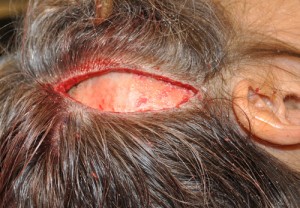Background: There are a wide variety of types of headaches of which migraines make up some of the most disabling. While the exact cause of many migraine headaches is not precisely known, certain types of migraines are known to occur from peripheral compression of certain cranial nerves. This has led to a variety of injectable Botox and surgical decompression surgeries to treat these very specific types of migraines.
One the of peripherally-based type of migraine headache occurs in the temporal region or the side of the head. Because the temporalis muscle is a chewing muscle such headaches often occur in people who grind their teeth due to stress. The zygomatico-temporal nerve branch (ZTBTN) comes through the temporalis muscle near the eye and can often be a source of temporal migraines. Treatment with Botox injections (diagnostic test for surgical treatment or simple avulsion of the nerve can produce noticeable improvement in the frequency and duration of these type of temporal migraine headaches.
But a false Botox test of the ZTBTN nerve or failure to produce a very pronounced reduction in the migraine headaches indicates that the compression of this small sensory nerve is not the true source of the problem. The overall size of the temporalis muscle and/or its repetitive contraction could then be more likely the headache source. This can be confirmed by a clinical examination of clenching of the teeth, feeling the expansion of the muscle and palpating for the location of the painful stimulus.
Case Study: This 56 year-old female had a long history of temporal headaches that had been refractory to every conceivable treatment. She knew that it came from clenching her teeth and was persistent on the side of her head. Dental splints, drugs and ZTBTN Botox injections did not provide relief. Botox placed all over the temporalis muscle provided some improvement but the dose requirement (50 units per side) was high and only temporary. (less than three months)

At one year after surgery, she reported a complete elimination of her migraine headaches. She did not have a single headache since the surgery. Her incisions healed inconspicously and she had no short or long-term effects on chewing or mouth opening.
Temporal muscle reduction may seem like a radical solution to the treatment of temporal migraines. But as an end treatment in the refractory migraine headache patient, it is a simple procedure that has no adverse functional effects.
Highlights:
1) Temporal (side of the head) migraines typically responds to Botox injections, ZTBTN nerve avulsion or ligation of the temporal artery.
2) When the source of temporal migraines is related to clenching and large bulging posterior temporal muscles, muscle reduction can be effective for which Botox injections would be the first treatment approach.
3) Temporal muscle reduction of its posterior belly is an end stage migraine treatment that can be effective in the properly selected patient.
Dr. Barry Eppley
Indianapolis, Indiana


